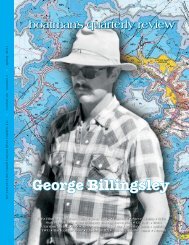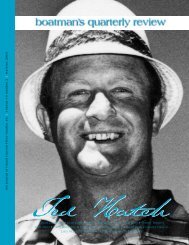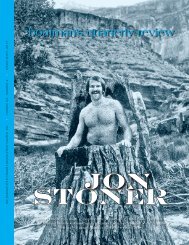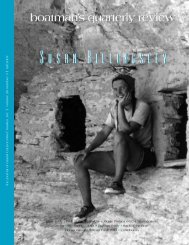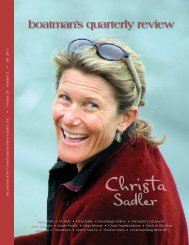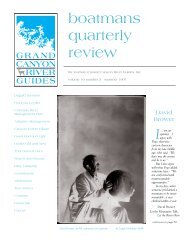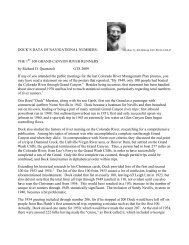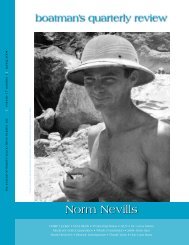boatman's quarterly review - Grand Canyon River Guides
boatman's quarterly review - Grand Canyon River Guides
boatman's quarterly review - Grand Canyon River Guides
You also want an ePaper? Increase the reach of your titles
YUMPU automatically turns print PDFs into web optimized ePapers that Google loves.
you are interested, please contact Lori Makarick at 928-<br />
226-0165 or Lori_Makarick@nps.gov to sign up for the<br />
event. Meet the nps project leaders at 11 a.m. at the<br />
Paria <strong>River</strong> parking lot, or look for people donning<br />
bright orange safety vests and wielding geology picks.<br />
The plan is to work until at 4 p.m. that day, but any<br />
time you can give will be greatly appreciated. If you sign<br />
up and get there on time, you will even get to partake<br />
in the deli spread lunch, a sign of the season to come!<br />
Tools and gloves will be provided, but volunteers will<br />
have to wear close-toed shoes (no sandals or flip-flops),<br />
long pants and a long-sleeve shirt, and bring water<br />
bottles (three liter capacity).<br />
If you are lucky enough to be going on the riverbased<br />
gts, you will get the rare, but highly satisfying<br />
opportunity to yank camelthorn plants out of the<br />
ground at Unkar and Crystal, the long-term control<br />
sites many of you have helped out with in the past. Not<br />
only will you get to wear work gloves and use shovels on<br />
the river, but you will also learn juicy tidbits about invasive<br />
plants that you can share with your future passengers.<br />
Lori Makarick<br />
Digging into the Past—Archeological Excavations<br />
along the Colorado <strong>River</strong> in <strong>Grand</strong> <strong>Canyon</strong><br />
<strong>Grand</strong> <strong>Canyon</strong> is both a natural and cultural<br />
landscape. There are few experiences as<br />
wondrous as running the Colorado <strong>River</strong> in<br />
<strong>Grand</strong> <strong>Canyon</strong> National Park. <strong>River</strong> runners descend<br />
into ever older rock units downstream from Lees Ferry,<br />
experience magical places such as Elves Chasm and Deer<br />
Creek Falls, and visit archeological sites such as Unkar<br />
Delta and the granaries at Nankoweap <strong>Canyon</strong>. Other<br />
evidence of the cultural aspects of the <strong>Canyon</strong> landscape<br />
includes many place names that reflect the <strong>Canyon</strong>’s<br />
long human history, such as Havasu <strong>Canyon</strong>. Currently<br />
eleven Indian tribes claim cultural ties to the canyon.<br />
The tribes include: Havasupai, Hopi, Hualapai, Kaibab<br />
Band of Paiute Indians, Las Vegas Paiutes, Moapa Band<br />
of Paiute Indians, Navajo Nation, Paiute Indian Tribe of<br />
Utah, Pueblo of Zuni, San Juan Southern Paiutes, and<br />
the Yavapai-Apache Nation. Three Indian reservations,<br />
Havasupai, Hualapai and Navajo Nation, adjoin the<br />
national park boundary.<br />
Despite the fact that people have lived in and used<br />
the <strong>Grand</strong> <strong>Canyon</strong> landscape for 12,000 years, archeologists<br />
know relatively little about the canyon’s prehistory.<br />
Approximately four percent of the park’s 1.2 million<br />
acres has been surveyed for cultural resources, and there<br />
have been few excavations of identified archeological<br />
sites. Given the National Park Service’s mandate to<br />
preserve and protect these nonrenewable resources,<br />
archaeological excavations are extremely rare in <strong>Grand</strong><br />
<strong>Canyon</strong> and only occur when the resource cannot be<br />
preserved in situ—i.e., in its original setting.<br />
Since the closure of Glen <strong>Canyon</strong> Dam in 1963, the<br />
amount of sediment available in the Colorado <strong>River</strong> in<br />
<strong>Grand</strong> <strong>Canyon</strong> has been greatly diminished. This lack of<br />
sediment replenishment has incrementally increased<br />
erosion of beaches and alluvial terraces, and decreased<br />
the availability of sediment for aeolian transport. The<br />
impacts of this sediment-starved system include the<br />
erosion, deterioration, and even loss of archeological sites<br />
in the Colorado <strong>River</strong> corridor. The March 1995 Final<br />
Environmental Impact Statement for the Operation of<br />
Glen <strong>Canyon</strong> Dam mandates scientific studies of cultural<br />
resources in the area potentially affected by the operations<br />
and existence of the dam. Additionally, a variety of<br />
federal laws, regulations and policies, including the<br />
National Park Service Organic Act, Archeological<br />
Resource Protection Act, and the National Historic<br />
Preservation Act require preservation of archeological<br />
resources in <strong>Grand</strong> <strong>Canyon</strong>.<br />
<strong>Grand</strong> <strong>Canyon</strong> National Park Service (grca) and<br />
the Bureau of Reclamation (bor) conducted an intensive<br />
inventory of archeological sites in the river corridor<br />
between 1990 and 1991. This survey identified 475<br />
Archaeologists excavating a storage room at Furnace Flats.<br />
Photo courtesy of Lisa Leap, NPS photo.<br />
boatman’s <strong>quarterly</strong> <strong>review</strong> page 7




